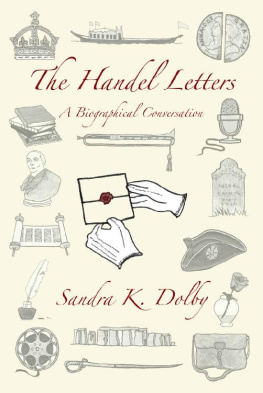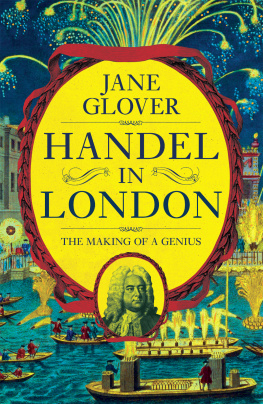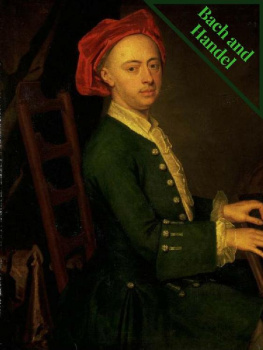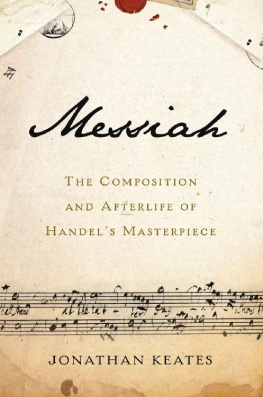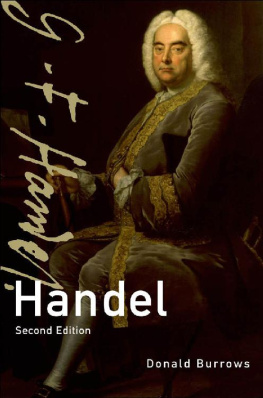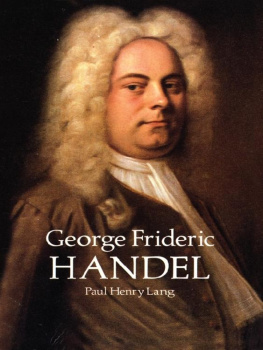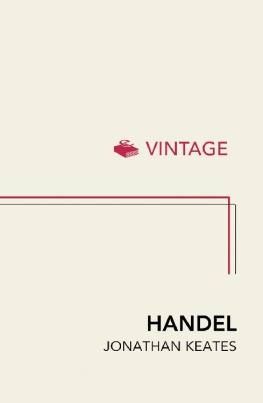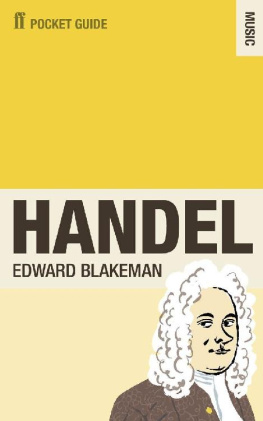The Handel Letters
The Handel Letters
A BIOGRAPHICAL CONVERSATION

Sandra K. Dolby
Copyright 2017 Sandra K. Dolby
All rights reserved.
Cover and chapter art by Alexis Stahl
ISBN-13: 9781977669179
ISBN-10: 1977669174
The Handel Letters: A Biographical Conversation is dedicated to the memory
of Mr. Cloyde Slater and to all who have worked to keep Handel
and his music alive, in our ears and in our hearts.
Some Brief But Relevant Biographies
George Frideric Handel (1685-1759) was a late Baroque period composer, best known for his oratorio Messiah and such orchestral pieces as the Water Music and Music for the Royal Fireworks. Though born in the city of Halle in Germany, Handel began a career as a composer of operas in Italy and then moved to London, his home for most of his adult life and the context for his outstanding musical career. He is most often credited with making the English-language oratorio a popular genre of classical music. He became a British citizen, was made a governor of the Foundling Hospital in London, was honored with a life-size statue on the grounds of Vauxhall Gardens, and is buried, along with other notable British exemplars, in Westminster Abbey.
Sandra K. Dolby is a folklorist, known primarily for bringing academic attention to the oral personal experience story. She taught for more than thirty years in the Department of Folklore and Ethnomusicology at Indiana University. She served as Director of the Folklore Institute for a brief time and also as an Adjunct Professor in the Department of American Studies. She continues to serve on the Faculty Committee of IUs Individualized Major Program. Publications include Literary Folkloristics and the Personal Narrative and Self-Help Books: Why Americans Keep Reading Them. She has also recorded a number of albums that include original songs, folk songs, and popular covers. Academic fellowships have taken her to Australia and to Norway. She currently lives in Bloomington, Indiana. See www.sandradolby.com.
Alexis Stahl is an artist, editor, and archivist who specializes in printmaking and has worked extensively with the preservation and archiving of art objects. She earned a BA degree from Newcomb College at Tulane University and an MFA from the University of Cincinnati. She currently lives in New Orleans and works in the Research and Design Department at Mignon Faget, Ltd. See www.alexisstahl.com.
Table of Contents

Preface

Our topic: Learning about and from the life of George Frideric Handel.

F ORTUNATELY FOR US, HUMANS ARE born with a great love and talent for learning. There are so many ways to learn and so many subjects, so many skills, strategies, and stores of knowledge. As an elementary school student in the 1950s, I always found the filmstrips shown in class riveting, even exciting. Usually these instructional aids were intended to show the parts of a flower or how some scientific experiment was carried out or how some animal behaved. We have much better technology now, of course, but I miss that almost clumsy attention to the process of learning, that patient unfolding of each step in our enlightenmentno matter the subject.
And so here, in this book about the composer George Frideric Handel, I explore an ancient and but underappreciated way of learningpurposeful conversation about someones life. Conversation is how we first learn and teach. We tell stories from our own lives. We listen to others talk of their own experiences. Occasionally we set aside time to do both of these things more formallyin a discussion group or seminar. That is my model herea topical seminar with ten or twelve participants.
And why Handel? Certainly there are many, many people interested in Handel. And there have been many books written on his life, on his music, on the times in which he lived. It is fair to guess that across the globe a high percentage of people know who Handel is and at least a little about him. Most will know of Handels Messiah and maybe even have memories of singing parts of the oratorio with a community chorus. Handel is a well-known figure who has inspired many excellent biographies, but the world could easily accommodate yet another attempt to present his life story. This book is one such attempt, but it is also an attempt to tap into the process of conversation as a learning tool and vehicle for values clarification.
In the not too distant past, as a university professor, I taught graduate seminars in a department of folklore and ethnomusicology. One source I found especially helpful in presenting the generally pertinent topic of relativism was a little book titled Whos To Say? The author, Norman Melchert, examined the subject of relativism through a series of conversations among a group of six fictional characters, each of whom represented a particular philosophical perspective. I think my students enjoyed contemplating the topic using this conversational format, especially as they had the opportunity to play-act a bit as we read it collectively. But I also think they learned more than simply the variety of perspectives Melchert hoped to present. They also learned how emergent conversations reveal the speakers character and values, howeach time he or she speaksthose individuals inevitably use the many frames of reference that help make them who they are.
In my own research on personal narratives, I have called this identity-based frame or constellation of sources the individuals cultural thumbprint. If you can imagine a flowera daisywith a center or pseudanthium that represents the individual and the petals attached to that center as various groups that influence that person, then you have my notion of the cultural thumbprint, the range of groups thatcollectively and over timeinfluences what a person values, thinks, or knows. In a conversationeven a conversation about Handelthe persons cultural thumbprint will show up in what he or she says in the context of that conversation. There is not simply one cultural frame that influences what a person knows or believes. There are many, and the overall constellation of influences is unique and evolving for each individual. That varying cultural and personal perspective is what I wanted to bring to my view of Handels biography.
Contemporary folklore research welcomes just about any topic as a subject of study. That inclusiveness was part of what drew me to the field years ago. For example, I could undertake a folklore fieldwork project that examines how real people actually do respond to what is known of Handels life, a project that asks what lessons those individuals might draw from thinking about his narrative. As a folklorist, I could carry out that fieldwork, analyze the recorded dialogues, and publish a scholarly monograph on the topic. I chose not to do that, but I think it would be a worthwhile study. Instead, I have chosen to create a fictional context loosely based on that hypothetical fieldwork design. And I haveagain very looselydrawn upon my own experience as a university professor and an American baby boomer to introduce, as seminar participants, characters who reflect something of the people I have known over the course of my life, though, to be sure, none of these fictional characters are stand-ins for any real people I have known.

